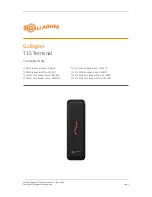
Manual Number: 00750-006-5
Page 14
ULTRA-485 Manual
Appendix A: Troubleshooting
A software testing utility is supplied with the adapter and will be used in the troubleshooting procedures.
By using this utility and following these simple steps, most common problems can be eliminated
without the need to call Technical Support.
1. Identify all I/O adapters currently installed in your system. This includes your on-board
serial ports, controller cards, sound cards etc. The I/O addresses used by these adapters
as well as the IRQ (if any) should be identified.
2. Configure your adapter so that there is no conflict with currently installed adapters. No
two adapters can occupy the same I/O address.
3. Make sure the adapter is using a unique IRQ. While the adapter does allow the sharing
of IRQs, many other adapters (i.e. SCSI adapters & on-board serial ports) do not. The
IRQ is typically selected via an on-board header block. Refer to the section on Card
Setup for help in choosing an I/O address and IRQ.
4. Make sure the adapter is securely installed in a motherboard slot.
5. For Windows 95/98/2000/ME and Windows NT, the diagnostic tool ‘WinSSD’ is installed
in the on the Start Menu during the setup process. First find the ports using the Device
Manager, then use ‘WinSSD’ to verify that the ports are functional.
Always use the diagnostic software when troubleshooting a problem. This will help eliminate any
software issues and identify any hardware conflicts.
The following are known I/O conflicts:
·
The 278 and 378 settings may conflict with your printer I/O adapter.
·
3B0 cannot be used if a Monochrome adapter is installed.
·
3F8-3FF is typically reserved for COM1:
·
2F8-2FF is typically reserved for COM2:
·
3E8-3EF is typically reserved for COM3:
·
2E8-2EF is typically reserved for COM4:





































